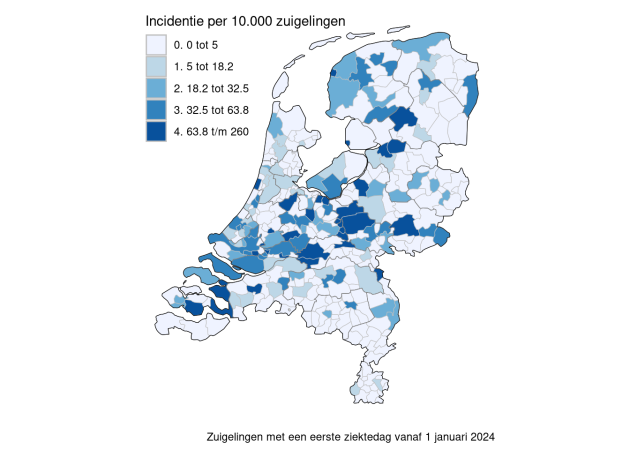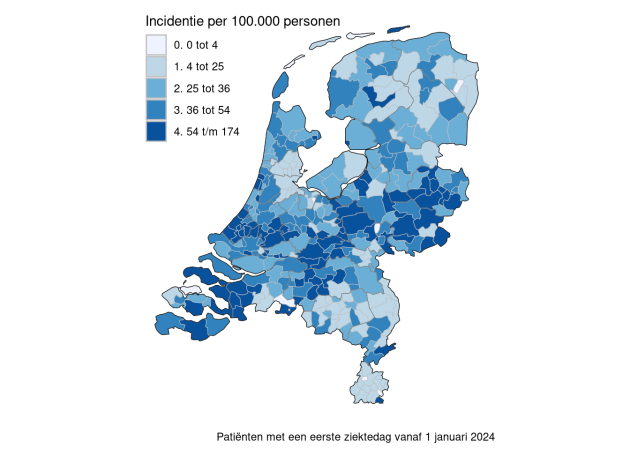Since 1996, there has been an increase in whooping cough cases in the Netherlands, among children and adults. There is a peak in reported cases of whooping cough every 2 to 4 years. This page presents the latest figures on whooping cough in the Netherlands.
Update 1 May 2024
The number of people with whooping cough in the Netherlands reported to RIVM every week is still very high. Echoing the trend of the first two weeks of April, more than 1,800 whooping cough cases were reported the past two weeks, including 50 infants. These figures are very high compared to recorded figures for every year since whooping cough was designated as a notifiable disease in 1975. Most of these people were already ill before the beginning of April.
From 1 January to 29 April 2024, there have been a total of 7,817 reported cases of whooping cough, including 375 infants. More than half of babies aged 0-5 months who have whooping cough were admitted to hospital. Just over one-quarter of babies aged 6-11 months went to hospital. 90% of babies aged 0-2 months who were reported to have whooping cough, and whose vaccination status is known, were not protected by maternal vaccination during pregnancy. Several of the babies with whooping cough who were born to vaccinated mothers had been born prematurely, or there had not been enough time between the vaccination and the birth. Vaccination during pregnancy offers very good protection against whooping cough infection in babies aged 0-2 months (90-95%). 88% of babies aged 3-11 months who were reported to have whooping cough, and whose vaccination status is known, were not vaccinated, or had not yet received all the immunisations scheduled for their age group.
In the second half of April 2024, RIVM received a report that someone over 70 years old who had whooping cough had died. Previously this year, the deaths of four babies and one person over 80 years old with whooping cough were reported to RIVM.
Data from the primary care database maintained by Nivel - the Netherlands Institute for Health Services Research - shows that, after two weeks of a downward trend, the number of patients with whooping cough symptoms visiting the GP is rising again, especially among young children aged 0-4 years.
17 April 2024: reported cases of whooping cough continue to rise
The number of people with whooping cough in the Netherlands reported to RIVM every week is still continuing to rise. In the first two weeks of April, more than 1,800 whooping cough cases were reported in total, including 50 infants. Most of these people were already ill before the beginning of April.
In 2024, there have been a total of 5,303 reported cases of whooping cough, including 276 infants. These figures are very high compared to previous years, and compared to the years before the COVID-19 pandemic. Nearly half of all babies with whooping cough were admitted to hospital.
Whooping cough cases have been reported all over the country. The number of municipalities where there are babies with whooping cough is still rising. A relatively higher percentage of whooping cough cases (including babies) has been reported in some municipalities in 2024. In April 2024, RIVM also received a report that someone over 80 years old who had whooping cough had died. Previously this year, RIVM received reports of four babies with whooping cough who had died.
Data from the primary care database maintained by Nivel – the Netherlands Institute for Health Services Research shows that GPs have seen fewer patients with whooping cough in the past 1-2 weeks. The number of children visiting the GP with whooping cough symptoms is also gradually decreasing.
3 April 2024: reported cases of whooping cough still rising
RIVM is still observing an increase in the number of people with whooping cough reported in the Netherlands. In the first few months of 2024 (January–March), more than 3,600 whooping cough cases were reported in total, including 228 infants. Half of these young children ended up in hospital. Some babies die from the effects of the disease
Vaccinating pregnant people and newborn babies is the main way to prevent severe whooping cough in small babies. A pregnant person who receives the vaccination in time is protected against whooping cough. This maternal whooping cough vaccination (ideally at 22 weeks of pregnancy) also ensures that the baby is protected right from birth. The vaccination prevents whooping cough infection in 9 out of 10 babies under 3 months old. In addition, RIVM still urges people who have a cough and sniffles to avoid contact with people in the late stages of pregnancy and newborn babies.
15 March 2024: Reported cases still rising and at least four infants have died
The upward trend in reported cases of whooping cough among children is continuing. RIVM had previously expressed concern about the increase. Since then, RIVM has received some 200-300 reports of children with whooping cough every week. At least 20 of these weekly reported cases were infants (children under 1 year old). Approximately half of the babies with whooping cough were admitted to hospital in recent weeks. In February and March, RIVM received notifications of four babies who died from the consequences of whooping cough.
The upward trend in the number of babies with whooping cough has been observed throughout the Netherlands. The increase was previously seen in the ‘Bible belt’. About 85% of the affected babies were not sufficiently protected against whooping cough because the baby and/or the mother were not vaccinated.
Vaccinating pregnant people and newborn babies is the main way to prevent whooping cough. A pregnant person who receives the vaccination in time is protected against whooping cough. This maternal whooping cough vaccination (ideally at 22 weeks of pregnancy) also ensures that the baby is protected right from birth. The vaccination prevents whooping cough infection in 9 out of 10 babies under 3 months old.
In addition, RIVM still urges people who have a cough and sniffles to avoid contact with people in the late stages of pregnancy and newborn babies.
Reported cases of whooping cough by month in 2018-2024
Doctors and laboratory managers notify the Municipal Public Health Services (GGDs) if a patient has whooping cough. The charts below show the number of people with whooping cough reported in the Netherlands from 2018 to March 2024. These are not yet complete, in particular for the past few months. This is because many reports are received later.
Grafiek kinkhoestmeldingen per maand
Skip chart Reported cases of whooping cough by month and go to datatableFigure 1: Number of reported cases of whooping cough with a first day of illness in 2018–2024, by month.
* Preliminary case numbers are shown for January–April 2024. Due to a delay between the first day of illness and the reporting date, reported cases in these months are still increasing.
Reported cases of whooping cough, 1976–2024
The figure below shows the reported cases of whooping cough per year since 1976. There were more reported cases of whooping cough from 1996–2020, also among adults. This is because the structure of the bacteria has changed. As a result, it is easier for the bacteria to cause illness in people who have already been vaccinated.
There was a peak in reported cases of whooping cough in 2012. There were far fewer reported cases of whooping cough between April 2020 and June 2023. It is likely that the measures to prevent the spread of COVID-19 also kept the whooping cough bacteria from spreading. As a result, few people built up immunity to whooping cough during that period. This may partly explain why we are seeing such an increase in whooping cough now.
Kinkhoestmeldingen
Skip chart Reported cases of whooping cough by year and go to datatableFigure 2: Reported cases of whooping cough in 1976–2024.
Cases from 1976–1988 are based on reporting date. Cases from 1989 on are based on the first day of illness. Stricter conditions for notification of whooping cough cases were in effect from 1988 to 1997.
* Preliminary case numbers are shown for 2024. These numbers are based on reported cases from 1 January to 29 April 2024
Infants with a first day of illness in 2024 in the Netherlands
The map below shows reported cases of whooping cough among infants aged 0–11 months, with a first day of illness in 2024. This involves case numbers per 10,000 infants, by municipality.
Figure 3: Total number of reported cases of whooping cough among infants in 2024, per 10,000 infants, by municipality in the Netherlands, with a first day of illness in 2024.
Reported cases of whooping cough among infants by month, 2018–2024
The chart below shows the number of reported cases of whooping cough among infants in the Netherlands, displayed by year and month of the first day of illness. This figure clearly shows how high the reported cases of whooping cough among infants rose in early 2024 compared to the past few years, and in comparison to the years before the COVID-19 pandemic.
Grafiek aantal zuigelingen per maand met kinkhoest
Skip chart Number of infants with whooping cough per month and go to datatableFigure 4: Absolute number of reported cases of whooping cough among infants in the Netherlands, by year and month of the first day of illness.
Reported cases with a first day of illness in March and April 2024 are still expected to increase, due to a delay between the first day of illness and the reporting date.
Reported cases of whooping cough by age, 2000–present
The figure below shows reported cases of whooping cough per 100,000 inhabitants by age group, from 2000 to the present day. Following the peak in reported cases of whooping cough in 2021, there was a downward trend in 2013. The decrease during the Covid years is also clearly visible in this figure.
Kinkhoestmeldingen per jaar per leeftijd vanaf 2000-2023
Skip chart Reported cases of whooping cough per year by age and go to datatableFigure 5: Number of reported cases of whooping cough per 100,000 inhabitants, by age group, in 2000–2024.
*Preliminary case numbers are shown for 2024. These numbers are based on reported cases from 1 January – 29 April 2024
All reported whooping cough patients in the Netherlands with a first day of illness in 2024, by municipality
The map below shows reported cases of whooping cough among all age groups, with a first day of illness in 2024. This involves the total number of reported whooping cough patients per 100,000 inhabitants, by municipality in the Netherlands.
Figure 6: Total number of reported whooping cough patients in 2024, per 100,000 inhabitants, by municipality in the Netherlands.
Because the case numbers per 100,000 inhabitants are displayed here, there are no municipalities that have more than 0 and fewer than 3 reported cases per 100,000 inhabitants.
Mortality due to whooping cough
Before vaccination against whooping cough was introduced in 1957, about 200 Dutch children died each year from the disease. After whooping cough vaccination was introduced in the Netherlands, the number of children with whooping cough fell sharply. From 1964 on, there were about 0–2 deaths from whooping cough annually in the Netherlands. As of 17 April 2024, the total number of deaths from whooping cough in 2024 is currently 5.
Kinkhoeststerfte 1957-2022
Skip chart Whooping cough mortality and go to datatableFigure 7a: Whooping cough deaths from 1957–2024 .
Source: Statistics Netherlands (CBS) Statline (until 2022) and Osiris (2023–2024).
* Preliminary case numbers are shown for 2022–2024.
Kinkhoeststerfte 1905-1955
Skip chart Whooping cough mortality and go to datatableFigure 7b: Whooping cough deaths from 1905–1956 (source: Statistics Netherlands (CBS) Statline).

